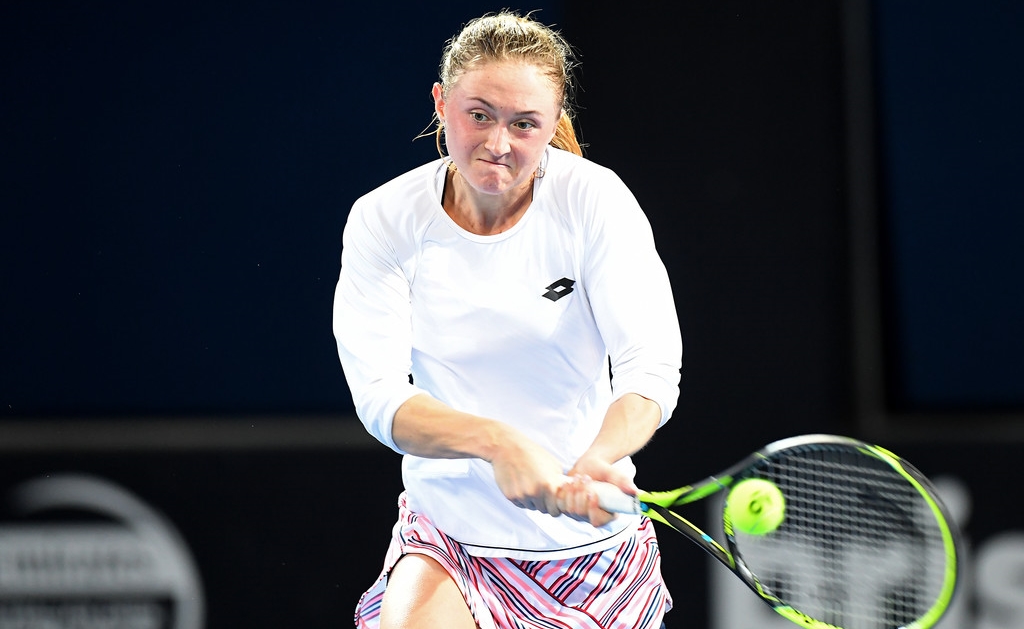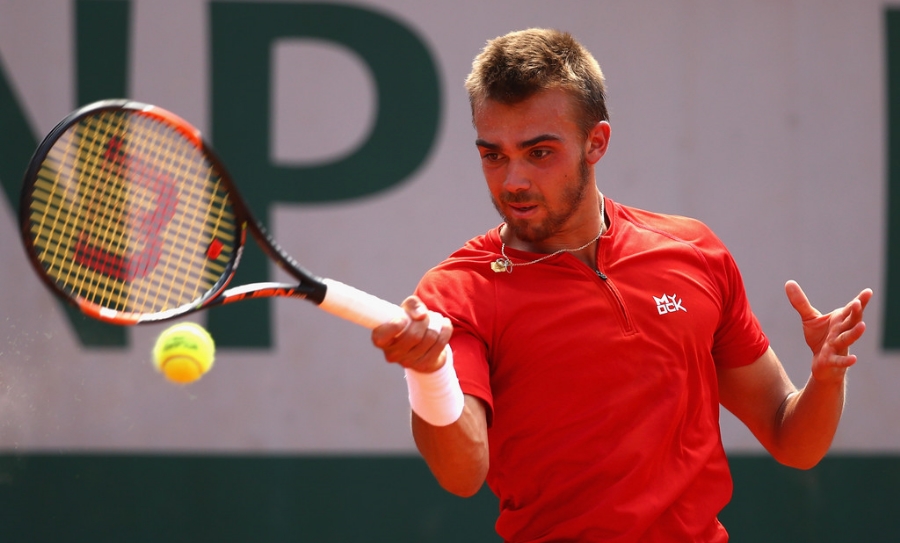Aliaksandra Sasnovich has been a steady performer on the WTA Tour, and on all surfaces, over the last three years. Two of her best results in her career came in 2018, first when she made the finals of the WTA Tour event in Brisbane, losing to Elina Svitolina, second when she stunned Petra Kvitova, one of the title favorites, in the opening round at Wimbledon and won two more matches to reach the fourth round, her best result in a Major. Sasnovich earned a career-high ranking of no.30 in that same year.
Though she eventually dropped below the top 100 in early 2020, she has had solid results since the tour resumed in August with Palermo Ladies Open, where she won six matches in a row as a qualifier to get to the quarterfinals before losing to top-seeded Petra Martic in two tiebreakers. Following a third-round loss to Yulia Putintseva at the US Open and another quarterfinal showing in Istanbul, Sasnovich arrived at Roland Garros ranked at no.96 in the WTA.

Her first-round opponent Anna-Lena Friedsam of Germany, ranked no.104, suffered several early-round losses this year, except in Marseille in March where she played her second career WTA final, losing to Sofia Kenin in three sets. It was back in 2016 that Friedsam reached her career-best ranking of 45, before injuries (particularly her shoulder) sidelined her for extended periods of times. After dropping as low as outside the top 300 in 2018, her career finally took an upturn recently. She finds herself on the verge of entering top 100 again.
Sasnovich and Friedsam, both born in 1994 and only 7 weeks apart, had already faced each other at the start of the 2020 season in Shenzen where the Belarusian defeated Friedsam 6-2 6-3.
Being the second match scheduled on Court 13 – click here to read my analysis of the first match between Benjamin Bonzi and Emil Ruusuvuori –, the two women were spared the steady drizzle that Bonzi and Ruusuvuori had been subjected to during the first two sets of their match. Nonetheless, conditions still remained piss-poor with cold temperatures and winds causing havoc in terms of shot-production by both players.
There is always the case of one player adjusting a bit quicker to weather conditions than the other, which could be due to one player’s fundamentals being more adaptable to different conditions than that of the other player, or to that player’s ability to remain more cool-headed than the other under adverse conditions. In any case, that player in this match was Sasnovich who actually lost her serve to start the match by committing three unforced errors in the first game while slipping and sliding on the court (she smacked the bottom of her shoe in frustration with the racket to get the clay off on the fourth point of the match). She did adjust quickly though, and made only two unforced errors for the rest of the set!
She also began to use her drops shots frequently, probably realizing that testing Friedsam’s first-step quickness forward may be something she could exploit further. Despite a bad drop shot that cost her the 3-1 game on her serve, that tactic worked in her favor for the duration of the set, throwing Friedsam out of balance during rallies and not allowing the German to settle into a rhythm. Friedsam made 10 unforced errors from 1-0 up to 2-6 down and by the time she decided to increase the velocity on her shots in an attempt to regain some control in rallies, it was too late.
Friedsam, determined not to find herself in the same situation as in the first set, made an emphatic statement to her opponent in the first game of the second set, producing two forehand winners and two high-octane returns that forced Sasnovich into errors. It could have been costly had she missed them, but ti was the right choice at that moment. The alternative was to play cautious and avoid errors, only to allow Sasnovich to hold the reins during rallies thanks to her variety, including drop shots (read: a rehash of the first set).
Friedsam held serve to go up 2-0 and continued to pound away, especially with her forehand. While Sasnovich remained within distance when she held serve at 1-3, you could tell that she was beginning to fear her opponents’ accelerations. She was straining to place her shots deeper in order to avoid Friedsam’s winner attempts that were now landing in for the most part — because that is what happens when you commit to a plan and believe in it; you embrace the risk itself instead of fearing its consequences. As Sasnovich’s targets became more and more limited in her increased attempts to keep Friedsam behind the baseline and off balance, she began to commit errors of her own and got broken a second time. Sasnovich’s unforced-error count more than doubled in the second set (11) while Friedsam, despite playing riskier tennis, cut hers down to 5 for the set.
When the third set began, it was Sasnovich’s turn to solve problems and make the pendulum swing back her way. She achieved that goal in the first game already by shifting to higher gear on the pace of her baseline shots and stripping away Friedsam’s ability to take the initiative. In doing so, she made three forehand unforced errors in that first game, but she managed to hold serve by forcing Friedsam into errors of her own. The difference between what she did right there at the beginning of the third set, and what Friedsam had done earlier at the beginning of the second (they both successfully managed to shift the momentum) was that Friedsam aimed for direct winners or sought to squeeze rapid, forced errors out of Sasnovich, whereas Sasnovich, instead of looking to end the point quickly one way or the other, added spin (or slice) as well as pace, but hitting closer to the lines, with the ultimate goal being, I presume, to keep Friedsam on the move and make herself be the one to set the patterns in rallies again.
It worked.
As Friedsam found herself in more and more difficult positions, she could not generate the same pace and reproduce the precision she enjoyed in the second set, and errors began creeping into her game. Once Sasnovich went up a break 2-0, the match had a new outlook. It was now the Belarusian directing traffic again during rallies, using the full range of varieties in her arsenal, from topspin to drive accelerations, to slices on both wings (including that rare and wicked inside-out slice that she can hit on her forehand), mixed in with drops shots for good measure. As an example, I would recommend a rewatch of the 2-1 game if you have access, the breaking point of the final set in my view. It starts and ends with two drop-shot winners by Sasnovich, and then, there is the crucial 30-30 point in the middle, where Friedsam responds to the challenge put forth by Sasnovich by coming into the net on a great approach shot (exactly what she should do at that juncture of the match and on that point) that puts Sasnovich on a full run to her backhand side. Yet, the Belarusian, thanks to her agility, hits a tremendous two-handed down-the-line passing shot on the full run, earning the break point, and probably delivering a devastating blow to Friedsam’s charge to sink her teeth into the final set — the German had just broken serve to get back to 1-2 and was serving to equalize at 2-2.
With her timing derailed and down by a break again after the above sequence, Friedsam’s unforced-error count once again skyrocketed. She tried to counteract the effects by coming to the net more often, and had only limited success with it because Sasnovich simply did not provide the German with enough chances to consistently come forward.
Friedsam finished the final set with 11 unforced errors, whereas Sasnovich made only four more after the initial three in the first game, before she concluded the match with 6-2 2-6 6-3 win. It was not a spectacular performance by any means, but it was extremely efficient considering the dreadful circumstances created by not only the lack of spectators (Ct. 13 looked deserted for most of the match), but also the miserable weather conditions. In short, it was an extremely professional day at the office for Aliaksandra Sasnovich.
Her second-round opponent is Caroline Garcia who took out the 17th-seeded Anett Kontaveit in three sets and I feel certain that Sasnovich will have plenty of additional problem-solving to do against the Frenchwoman.

